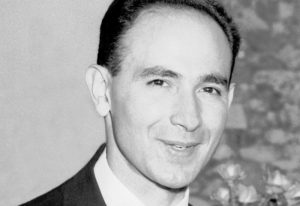The Montgolfier brothers

Joseph-Michel Montgolfier (1740-181o) and Jacques-Étienne Montgolfier (1745-1799) are chiefly known for their pioneering inventions in the field of hot air balloon aviation, but they also contributed a lot to the field of paper manufacturing. Among other things, the brothers developed a process to manufacture transparent paper that looked like vellum, based on a technique from England, and in 1796, Joseph-Michel invented a self-acting hydraulic ram to raise water to a paper mill in Voiron.
In 1738, Jacques-Étienne made the first confirmed human flight in a Montgolfiére-style hot air balloon (globe aérostatique). This is the earliest confirmed piloted ascent by man.
The paper-producing Montgolfier Company still exists in Annonay today, but under the name Canson. It produces fine art papers, drawing papers and papers for photography.
Background
Joseph-Michel and Jacques-Étienne Montgolfier were born into a family of paper manufacturers in Annonay, a city in the Auvergne-Rhône-Alpes region of southeastern France. Their parents were Pierre Montgolfier (1700–1793) and his wife Anne Duret (1701–1760). The family had a total of 16 children, and Joseph-Michel Montgolfier, born in 1740, was their 12th child, while Jacques-Étienne Montgolfier, born in 1745, was child number 15.
Joseph-Michel was described as a maverick and a dreamer, and not very good at dealing with practicali ssues regarding neither business nor personal affairs. Jacques-Étienne had more of a talent for business and practical applications, and was sent to Paris to train as an architect.
When the oldest brother Raymond died in 1772, Jacques-Étienne was called back to Annonay to fill his role as successor to the family business. In the following ten years, Jacques-Étienne proved to be great at coming up with technical innovations for paper production, and also successfully studied and incorporated new innovations from the Netherlands.
Early experiments with hot air balloons
Joseph-Michel was became interested in aeronautics before his brother, and started creating parachutes as early as 1775. He even jumped with one from the family house.
When observing how laundry drying over a fire billowed upwards, it gave Joseph-Michel the idea of building a flying machine based on this phenomenon. In November 1782, while living in Avignon, he began his experiments.
Joseph-Michel believed that the smoke was the buoyant part and that it contained a special gas, which he named Montgolfier Gas. Therefore, his tried to use very smouldering fuel for his experiments.
One of his early creations was a chamber of thin wood, measuring 1 x 1 x 1.3 metres. It was covered with lightweight taffeta cloth on the sides and top, and when Joseph-Michel crumpled and lit some paper underneath, the whole thing lifted off its stand and rose up through the air until it reached the ceiling.
Encouraged by this success, Joseph-Michel asked his brother Jacques-Étienne to help him. Together, they built a similar – but larger – box. On the 14th of December, 1782, they made a fire under it with wool and hay, and the box flew up and away from them. It landed nearly 2 kilometres away and was destroyed by passers-by.
First official demonstration of hot air balloon
On the 4th of June, 1783, the brothers successfully flew a hot air balloon in front of a group of dignitaries. The flight lasted 10 minutes and covered 2 km, and the estimated altitude was 1600-2000 metres.
The balloon consisted of four pieces (dome + three lateral bands) of sackcloth held together by 1 800 buttons, and was tightened with three thin layers of paper inside. On the outside, it had a fish net of cord for reinforcement. The contraption weighed 225 kg and could contain almost 790 cubic metres of air.
Soon, Étienne travelled to Paris to demonstrate their invention in the French capital.
First instance of living beings flying in a hot air balloon
For the demonstration in Paris, the brothers collaborated with the wallpaper manufacturer Jean-Baptiste Réveillon and constructed a very beautiful sky blue hot air balloon decorated with golden flourishes, signs of the zodiac and suns. The balloon held over 1 000 cubic metres of air and consisted of taffeta coated with varnish of alum. (The varnish made it less likely to catch fire.)
A smaller test was carried out on 11 September, at the garden of the hôtel Folie Titon,
not far from Réveillon´s house.
Then, the famous trailblazing demonstration with live creatures in the basket of a Aérostat Réveillon took place at the royal palace in Versailles, on 19 September 1783. The basket contained a duck, a rooster, and a sheep named Montauciel.
- The sheep was included because it was assumed to provide a reasonable approximation on how flying high in a balloon would impact a human.
- The duck was included as a control. Since ducks already fly high, it would show if any bad impact was the result of the aircraft and not the altitude.
- The rooster was included as another control, as roosters fly but not high.
The flight lasted circa eight minutes and covered around 3 km, with the balloon reaching an altitude of approximately 460 metres. It landed safely, and all the animals survived.
Among the people watching the demonstration was King Louis XVI and Queen Marie Antoinette.
First human flight in a hot air balloon (with tether)
Since the animals, including the sheep, survived the flight from Versailles, plans were put in action for a manned flight the following month. The brothers and Réveillon built a balloon capable of holding 1,700 cubic metres of air. It was blue and adorned with rich decorative gold figures, including signs of the zodiac, fleur-de-lis, suns with the king´s face in the centre, and the royal monogram. At the base of the balloon, they placed red and blue drapery and golden eagles. The balloon was roughly 23 m tall and 15 m in diameter.
Jacques-Étienne Montgolfier became the first person to fly in the basket of the balloon, in a tethered test flight from the yard of Réveillon´s workshop in Faubourg Saint-Antoine (a suburb of Paris, east of the Bastille). Exactly which day this happened is unclear, but 15 October is the most likely date. Later on the same day, the chemistry and physics teacher (1754-1785) Jean-François Pilâtre de Rozier became the second person to ascend into the air in a hot air balloon. The length of the tether was circa 24 metres.
First free-flight by human in hot air balloon (no tether)
The first free flight (no tether) by humans took place on the 21st of November, 1783, when Pilâtre de Rozier and the marquis François Laurent d’Arlandes (1742-1809) flew about 910 metres above Paris.
The trip started from the grounds of Château de la Muette in the western outskirts of Paris and covered around nine kilometres. After 25 minutes of flight, the balloon landed between the windmills at Butte-aux-Cailles outside the city ramparts. When it landed, it still had enough fuel left to fly four to five times as far.
A problem occurred during the flight: burning embers scorched the balloon fabric and the passengers had to daub them out, as they feared the balloon would be destroyed.
Fame and accolades
The pioneering flights in the Montgolfier balloons were a huge sensation, especially in France where numerous engravings commemorated them and a bit of a balloon-craze swept the nation. In December 1783, the father Pierre Montgolfier was elevated to the nobility by the King Louise and got the hereditary appellation de Montgolfier.
In 1983, the Montgolfier brothers were inducted into the International Air & Space Hall of Fame at the San Diego Air & Space Museum in California, USA.





